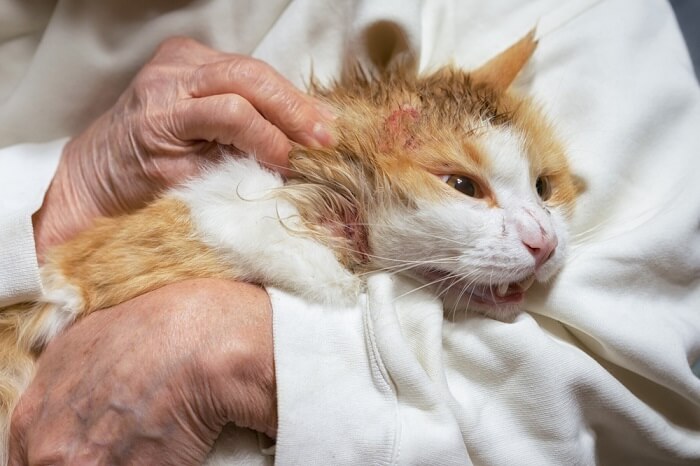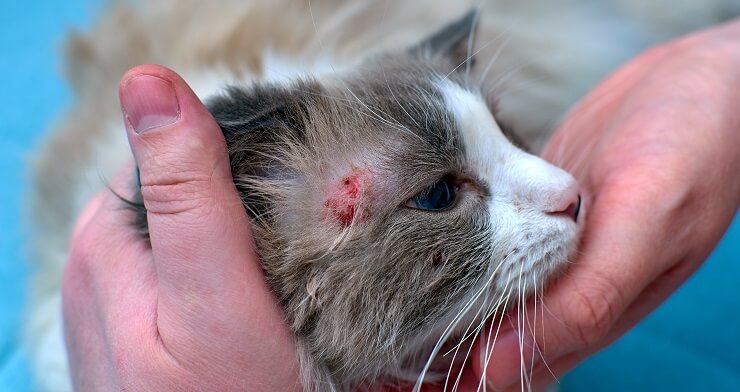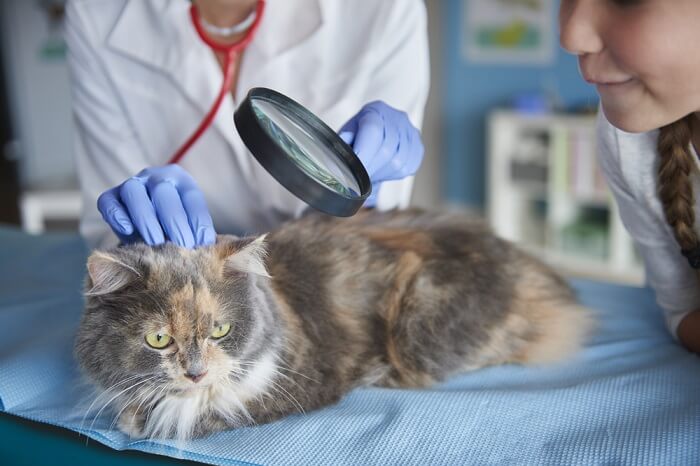
This article aims to give you clear facts about the common causes of skin problems in cats, and what can be done to help affected animals.
Why Do Cats Experience Skin Problems?
There are many different reasons for cat skin conditions, but the most common course of events is that something irritates the skin, causing inflammation of the cat’s skin (so-called “dermatitis”).
Inflammation is defined as redness, soreness (itchiness), heat, swelling, and loss of normal function: all of these features are seen in dermatitis.
Regardless of the initiating cause, this itchiness tends to lead to self-trauma (the cat scratching, licking and biting affected areas) and this then often makes the skin even more inflamed, aggravating the problem.
What Causes Cat Skin Problems?

There are seven common causes of feline skin disease (and there are other, less common causes too).
- Flea bites: flea infestations are the most common cause of skin disease, even when you cannot see any fleas on the cat. Around 70% of itchy cats referred to skin specialists are completely cured simply by instigating a thorough flea control program, even when no fleas have been seen, indicating that flea allergy is the underlying cause.
- Food allergy or intolerance.
- Atopy (environmental allergies including house dust mite and pollen allergy)
- Insect bites (such as harvest mites)
- Ear mites and other mites
- Bacterial infections including feline acne and abscesses
- Fungal infections (ringworm)
What Are the Signs of Skin Disease?

The most obvious sign of skin problem in cats is the cat scratching or licking themselves. At first, this may just appear to be excessive grooming, or over-grooming at first, but this behavior often makes a mild condition far worse.
The five main signs that owners may notice when a cat has a skin problem are:
- In conditions that cause itchy skin, the most obvious sign is the cat scratching or licking themselves due to itchiness. This may just appear to be excessive grooming, or over-grooming at first. This behavior often makes a mild condition far worse, as excessive scratching and licking often cause further damage to the skin. Accessibility of certain areas makes them more likely to be affected (e.g. underside of abdomen, which is easy for a cat to lick).
- A reddened, sore-looking area.
- A balding area of fur, with obvious hair loss (so-called alopecia) causing bald patches.
- Scabs, or bumpy areas of skin (so-called miliary dermatitis).
- Dandruff, with dry skin and excessive skin scaling.
Also Read: Cat Dandruff: Causes, Symptoms, Treatment, and Remedies
How Does a Veterinarian Tackle a Skin Problem in Cats?

Physical Examination
Any investigation of any problem in a cat starts with a careful, thorough physical exam of your pet. A cat with a skin condition may have other signs of ill health, and it’s important to rule out other underlying diseases.
It’s also important to note the precise location of any affected areas of skin, and to examine the precise type of changes in the skin and the fur. Sometimes it’s possible to visually identify the cause of the skin problem (e.g. fleas or harvest mites).
Your veterinarian may use an otoscope to examine the inside of your cat’s ear canals to check for ear mites.
Woods Lamp Examination
A Woods lamp (ultraviolet light) may be used to check for the presence of fluorescence which may indicate the presence of ringworm.
Skin Scrapings And Hair Plucks
A hair pluck may be collected and skin scraping may be taken (using the edge of a scalpel blade). These will be examined in the laboratory (either in-house, or sent to an external laboratory) to check for causes of the skin problem (e.g. some parasites, ringworm etc).
Dietary Trial
There is no blood test that is effective for skin disease caused by a food allergy: the only effective diagnostic tool is to put the cat onto a dietary trial.
The cat’s food must be nothing but a diet that they have never had before, so that there is no way they can be allergic to it. A home-prepared diet is sometimes used, or you may prefer a special ‘hypoallergenic’ diet from your vet.
Also Read: Elimination Diets For Cats: What You Need To Know?
You have to ensure that your cat eats nothing else for this period, which can be tricky if you have a multiple cat household, or if your neighbor sometimes feeds your cat.
If your cat stops itching when on the special diet, this strongly suggests that the cat must have been allergic to something that they were previously eating.
The cat must then be kept on the special hypoallergenic diet for the long term, or different diets with restricted ingredients can be trialed, try to fine-tune which ingredient is causing the skin problem.
Review of Possible Environmental Allergies or Irritants

An allergic reaction to specks of dust and pollens is not well understood in cats. It’s difficult to diagnose definitively as cats don’t react as predictably to the type of skin or blood tests that are used in other species.
Your veterinarian may suggest reviewing your cat’s environment to identify any obvious irritants or allergens that could be causing the skin disease (such as household cleaners, sprays, or new carpets etc).
Atopy – an allergic reaction to specks of dust and pollens – is less well understood in cats compared to humans and dogs. It’s difficult to diagnose definitively. Cats don’t react as predictably to the type of skin or blood tests that are used in other species.
Often atopy is a diagnosis of exclusion: if every other cause is ruled out, and if it responds to anti-inflammatory medication, it may be presumed to be atopy.
Skin Biopsy
In some cases, a skin biopsy may be recommended: this involves surgically removing a small section of skin, usually under general anaesthesia, to be sent to an external laboratory for detailed examination by a pathologist under the microscope.
Direct sampling of skin lesions in this way allows full scrutiny of the different structures of the skin, including hair follicles, any ulcers, granulomas, pimples, and other abnormalities.
Trial Treatment
Even if a diagnosis is not fully confirmed, veterinarians will sometimes give a trial treatment, and the response to this can help to make a presumptive diagnosis.
For example, if a cat develops a certain pattern of skin disease in the summer months, a veterinarian may suspect atopy (allergies to pollens) as the cause, and a trial treatment may be given (e.g. a depot injection of corticosteroids which lasts for three to four weeks).
If this is effective, this may be taken as strongly suggesting confirmation of this diagnosis, and future treatments can be arranged with this in mind.
Referral to a Specialist
Rarely, your local veterinarian may recommend referral to a veterinary dermatologist, who has a special interest in skin disease. This is generally recommended for exceptionally unusual cases.
Treatment Options for Skin Disease in Cats

Some causes of skin disease in cats may require the use of medication, with the most common being anti inflammatory, anti fungal, shampoos and nutritional supplements.
To deal with skin problems, a two-pronged approach is often needed:
- Give medication to initially stop the inflammation, so that self-trauma stops, giving the skin a chance to heal.
- Identify and remove the underlying cause of the inflammation so that the problem does not recur.
Treatment for feline skin disease depends on the cause of the problem:
- Fleas: the cat needs to be treated for fleas, any in-contact animals need to be treated for fleas, and the cat’s environment needs to be treated for fleas and flea eggs with a special spray.
- Food allergy or intolerance. The cat needs to be kept on a special diet that does not provoke an allergic reaction.
- Atopy (house dust mites and pollen allergies). Long-term anti-inflammatory medication is often needed to deal with these cases of hypersensitivity to allergens (see below). This may need to be given just for a particular time of year (in seasonal cases involving pollen) or all year round (in cases where there is a continual presence of allergen, such as house dust mites).
- Insect bites (such as harvest mites). As well as preventing contact with insects, anti-inflammatory medication is often needed.
- Ear mites and other mites. Treatment of the specific parasite needs to be given; again, anti-inflammatory medication may need to be given until the itchiness has fully settled down.
- Bacterial skin infections (such as feline acne) may need courses of antibiotics as well as topical treatments.
- Fungal infections (ringworm). Topical (on the skin) and systemic (in the food) antifungal medication may be recommended.
Medication for Skin Disease in Cats
As noted above, several different causes of skin disease in cats (especially skin allergies) may require the use of medication. The most common treatments include:
- Anti-inflammatory medication. This may be given as tablets (e.g. prednisolone), oral liquids (e.g. cyclosporines), or depot injections (which last 3 – 4 weeks). These are prescription-only medications so they need to be used under the careful supervision of your veterinarian.
- Anti-fungal and/or antibacterial medication, topically and/or systemically
- Antihistamines may sometimes be suggested.
- Shampoos may be recommended as topical treatments for a number of different skin diseases.
- Dietary supplements such as omega 3 and 6 essential fatty acids are often recommended to generally improve the health of the skin and to improve the skin barrier.
Skin problems are common in cats. It’s important to work with your DVM veterinarian to identify the cause of the skin disease so that appropriate treatment can be given.







